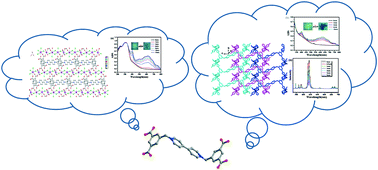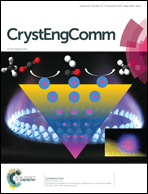Photochromic and photomodulated luminescence properties of two metal–viologen complexes constructed by a tetracarboxylate-anchored bipyridinium-based ligand†
Abstract
In this study, two metal–viologen complexes, formulated as [Cd1.5(H2L)0.5(Cl)3(CH3OH)]n (1) and [Eu2(L)(NO3)4(HOCH2CH2OH)2]n (2), were constructed by a tetracarboxylate anchored bipyridinium-based ligand 1,1′-bis(3,5-dicarboxybenzyl)-4,4′-bipyridinium dichloride (H4L·Cl2). Single-crystal X-ray analyses revealed that complex 1 featured a 2D-layered structure, while complex 2 showed a 1D “ladder-like” chain structure. The difference in the central metal ions, anions, solvent molecules, deprotonation degree of the tetracarboxylate ligand, coordination modes and conformations of the ligand have a great influence on the final structure. As expected, incorporation of the viologen moiety to the frameworks led to the predefined photochromism: when samples 1 and 2 were exposed to UV-visible light, a reversible color change from light yellow to blue/dark blue occurred. Moreover, complex 2 exhibited the characteristic emission of Eu(III) ion in the visible region, and it also displayed an interesting reversible tunable photo-induced luminescence switching behavior: under the irradiation of UV-vis light, the luminescence emission intensity of complex 2 gradually decreased and reached 15% of the starting value after 8 min. These results may not only help to further understand the structure–photoresponse relationships of viologen-based MOFs, but also help to guide the design and synthesis of luminescent materials with photo-modulated switching ability.

- This article is part of the themed collection: Editor’s collection: Chromism in Frameworks


 Please wait while we load your content...
Please wait while we load your content...